By Steve Colligan 04/06/2020
In April 2018, I took the opportunity to dive with Hammerheads in a very unique place off the northern side of Borneo, in the South China Sea. Two hundred miles from Sabah, Malaysia, is a small atoll called Layang Layang. The atoll consists of a landing strip, Malaysian naval base and dive resort…… and that’s it. There’s no roads, vehicles, village or shops. The very small island is surrounded by warm, crystal clear waters. The visibility is between 30-60 metres and the coral walls plunge 2,000 metres to the seabed below. The waters are totally unspoilt and unpolluted, and so the corals are in pristine condition. Because of a heavy monsoon, the dive resort is only open between March and October. Layang Layang is well know for the opportunity to dive with schooling Scalloped Hammerhead Sharks. For approx. six weeks, between 1st April until mid May, these Hammerheads are in bigger numbers, as they come looking for a mate. In addition to the Hammerheads, there is also the possibility of spotting other pelagic, like Mantas and Whale Sharks. Of course there are the usual tropical marine life to be found in abundance too.
The dive resort limit the number of divers on the island at any one time. During the Hammerhead mating season it becomes more difficult to secure a place, as demand increases. I tried to book a place the year before but failed. The following year I booked 6 months in advance, once the booking system opened. There is only one way of getting to Layang Layang and that’s by air from Sabah’s state capital, Kota Kinabalu, just over an hour away.
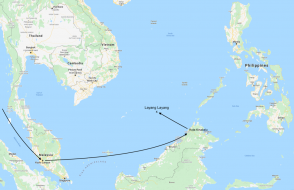
The dive resort charter the plane purely for transporting divers to/from Layang Layang and manage all bookings. This ensures the only people on the flight already have a reservation at Layang Layang.
Even though the accommodation is on land, it was a little like being on a liveaboard. You pay an all-inclusive price that covers 5 meals a day, accommodation and of course, the diving. The dive centre is part of the resort and only 1 minute walk away. Each of the dive boats holds 10 divers and 1 guide and takes a few minutes to get to the dive sites. After each dive, the boat returns to the dive centre for you to take your surface interval. There are 3 guided dives a day, plus unlimited selfguided dives around the pier area if you want.
Anyway…..I had seen lots of YouTube clips showing hundreds of schooling Hammerheads at Layang Layang and that’s what inspired me to go. There are only a handful of places around the world where you can see schooling hammerheads in their hundreds. I was beside myself with excitement as I flew the first leg of my journey to Malaysia’s capital, Kuala Lumpur. As always, I had taken all my own dive equipment, even though you could hire gear there. After overnighting in Kuala Lumpur, I flew onto Kota Kinabalu, in Sabah. I had given myself a couple of days in Kota Kinabalu to rest and allow time for any lost luggage to hopefully catch up with me.
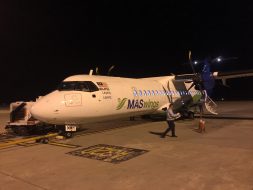 The flight from Kota Kinabalu to Layang Layang was at 5.45am but all passengers had to arrive at the unsociable time of 4.15am to complete various paperwork. There were about 20 other divers on the flight, including several Brits. For whatever reason, most of the other divers on the flight and at the resort were Chinese. As the flight was just over an hour long, night had turned to day by the time the plane was circling over Layang Layang. I had a superb view from my window-seat of this tiny atoll. I remember being really excited, finally arriving at this world class dive destination and the prospect of diving with lots of Hammerheads. As the photo shows, the runway covers the full
The flight from Kota Kinabalu to Layang Layang was at 5.45am but all passengers had to arrive at the unsociable time of 4.15am to complete various paperwork. There were about 20 other divers on the flight, including several Brits. For whatever reason, most of the other divers on the flight and at the resort were Chinese. As the flight was just over an hour long, night had turned to day by the time the plane was circling over Layang Layang. I had a superb view from my window-seat of this tiny atoll. I remember being really excited, finally arriving at this world class dive destination and the prospect of diving with lots of Hammerheads. As the photo shows, the runway covers the full
length of the island.
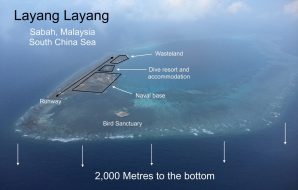
The naval base and runway adjacent to it are strictly out-of-bounds to everyone. The remainder of the runway and wasteland next to the dive resort are unrestricted for walks if you want. It only takes 2 minutes to walk from one side of the island to the other; there is literally nothing there. With so few flights it was quite a surreal experience walking along the runway in the evenings to watch the sunset. The island itself is literally about a metre above sea level. It was certainly impressive to think, all around the atoll there was a 2,000 metre drop to the seabed; not the place to drop your camera!!
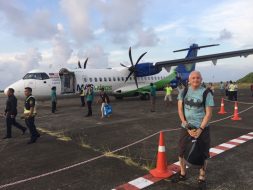
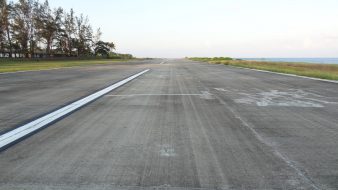
After the plane had landed, everyone was escorted to the resort, a 2 minute walk away, for a welcome drink and more paperwork. We were then briefed on the resort, meals and diving. With good reason, diver safety played a major part in the briefing. Diving with these Hammerheads would entail hanging around ‘in the blue’, waiting for them to show. This would be done just offshore, but with no visual reference to depth or land once down there. You were completely surrounded by blue water, and so it was essential to continually monitor your depth on your computer. Layang Layang is literally in the middle of nowhere and has no access to a hyperbaric chamber. Because of this, there were strict rules to abide by, to reduce the risks of decompression sickness. All dives were to be no-decompression dives. There was also a strict policy on not going
below 40 metres. With paperwork and briefings out of the way, everyone made their way to their rooms to unpack dive gear and get ready for the first dive, 2 hours later.
The dive centre was right next to the accommodation and also the pier from where the boats departed. All the dive boats were identical in design and comfortably held 10 divers and 1 guide. The departure of each boat was staggered by 15 minutes to help avoid congestion if groups were going to the same dive site.
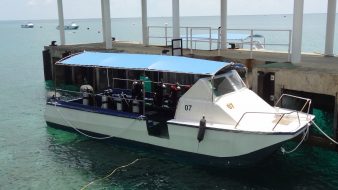
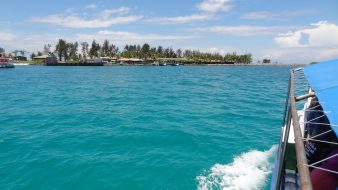
There were approx. 16 dive sites around the atoll. A lot of them had shallow coral reefs next to a wall that would descend into the abyss below. In theory, the Hammerheads could show up anywhere, but there was a better chance of bigger numbers at a dive site called ‘the Point’. The first two dives were at ‘the Point’ each day, followed by a shallow third dive at various other sites around the atoll. Hammerheads prefer the cooler waters, and since the water temperature was 26-30 deg. C they rarely came shallower than 30 metres. At ‘the Point’ we would hang around ‘in the blue’, between 30-40 metres, waiting for the Hammers to show below. On occasions though, they did come up and I managed to get some good views of these strange and magnificent creatures.
Looking back through my log book, I recorded seeing Hammerheads on 8 of the 18 dives. On several of the dives I only saw 1 or 2; a couple of the dives I saw half a dozen and on 1 dive there was a school of approx. 20. When not hanging around ‘in the blue’ looking for Hammerheads, the diving on the reefs was excellent with lots to see. I even saw a couple of Manta Rays from a distance. There was one other thing of interest that I’ve never come across before, and this was to be found at a particular dive site at 40 metres…
In 2015 the Malaysian Postal Department installed an underwater postbox at Layang Layang (see photo), permanently fixed on a ledge at a depth of 40 metres. You can 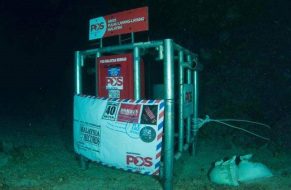 purchase waterproof postcards at the resort reception and then post it on one of your dives. The postbox is emptied once or twice a week by an underwater postman. A stamp is then added before going through the postal system to reach its destination. At that time, it was the deepest underwater postbox in the world and I think it still retains that honour.
purchase waterproof postcards at the resort reception and then post it on one of your dives. The postbox is emptied once or twice a week by an underwater postman. A stamp is then added before going through the postal system to reach its destination. At that time, it was the deepest underwater postbox in the world and I think it still retains that honour.
It was difficult to resist the temptation to post something at 40 metres and see if it actually reached its destination. Writing on the waterproof postcard wasn’t that easy with the well-worn permanent pens they had at reception. The dive centre then do a special dive for everyone who wants to post their cards.
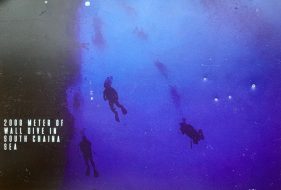
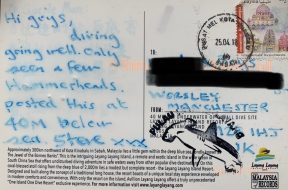
This was a 10 minute boat trip, then diving down to 40 metres to the postbox. Unfortunately, there was silt on the ledge where the postbox sat and was being kicked up by each diver posing for photos whilst posting their cards. It was essential to take a torch, as the wall cast a shadow over the ledge and postbox, making it very dark. It was a new experience and I can honestly say, both the cards I posted reached their intended addresses within a couple of weeks.
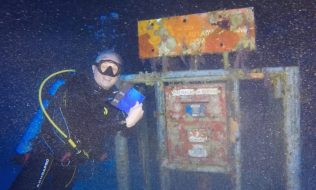
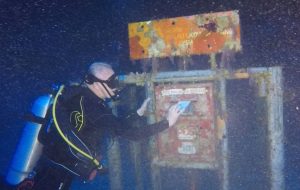
I enjoyed the whole experience of diving at this remote Malaysian outpost. It was such a buzz to see those big strange looking sharks. Even though I didn’t actually see the large schools I was hoping for, I still felt privileged to have had the opportunity to dive with them.
Please enjoy watching the short video I produced of my diving at Layang Layang. You can either click this link, or search on YouTube for Steve Colligan and Layang Layang. For other dive videos of mine, click here.
